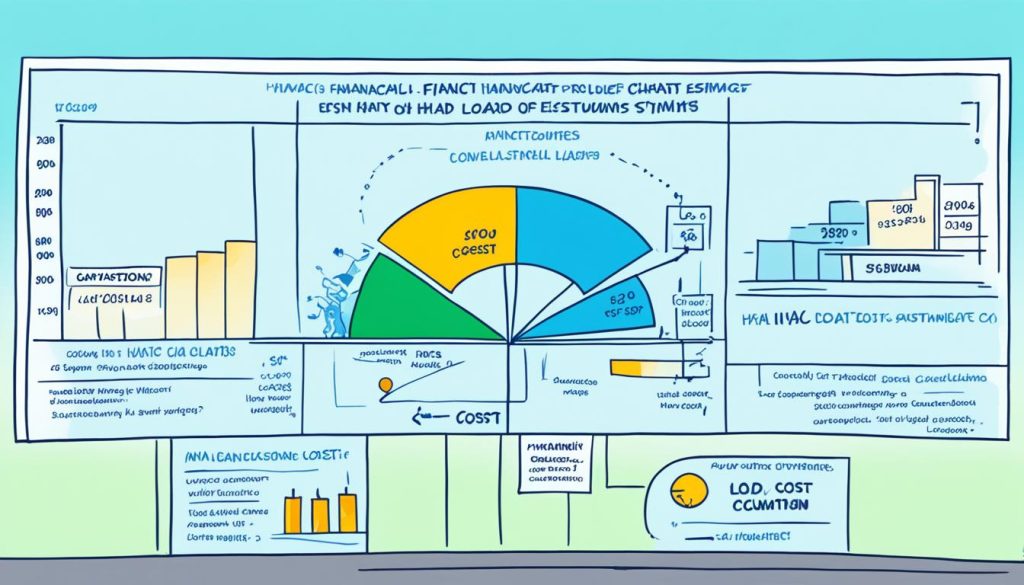Using HVAC load calculations can make your project cost estimation and financial planning more accurate. By looking at building plans and figuring out what you need, you get a clear idea of your HVAC system requirements. This helps you avoid making costly mistakes and improves your bid accuracy.
HVAC load calculations are key in managing construction projects. They look at building size, insulation, and climate to find the right heating and cooling systems. With these accurate calculations, you can refine your cost estimation and make better financial choices.
Learning HVAC load calculations gives you an edge in planning projects. You can give clients more precise estimates and manage your resources better. This skill is vital for anyone working in HVAC design, installation, or construction management.
Understanding HVAC Load Calculations
HVAC load calculations are key to figuring out what heating and cooling a building needs. They are important for planning and managing resources in construction projects. By knowing the HVAC needs, you can make sure the building stays comfortable and uses energy wisely.
Definition and Importance
HVAC load calculations measure how much heating or cooling a space needs to stay comfy. This is crucial for sizing the system right and saving energy. Getting it right means avoiding systems that are too big or too small, which can cost more and make people uncomfortable.
Key Components of Load Calculations
Several things go into HVAC load calculations:
- Building specs like size, insulation, and windows
- How many people will use the space
- The climate and how much sun the space gets
- Heat from inside the building like appliances and lights
These factors help figure out how much heating and cooling the space needs. Getting these right is key for planning materials and resources.
Impact on Project Cost Estimation
HVAC load calculations play a big role in estimating project costs. They affect:
- What equipment you need and how big it should be
- The design and materials for ductwork
- How efficient the system will be
- Costs over time
Adding load calculations to your planning means you can make more accurate cost estimates for HVAC systems. This helps with budgeting and planning resources from start to finish.
The Process of Performing HVAC Load Calculations
Calculating HVAC loads is key in planning construction and managing budgets. It helps figure out the right size for heating, ventilation, and air conditioning systems. This ensures the building stays comfortable and saves energy, all while keeping costs in check.
First, you look at the building’s blueprints. You check the layout, how it faces, and the materials used. Things like insulation, windows, doors, and electrical setups matter too. For older buildings, you must pay extra attention to their insulation and single-pane windows, which affect HVAC needs.
Then, you evaluate the building’s thermal envelope. This means looking at how heat moves through walls, the roof, and floors. You also consider inside heat sources like lights, appliances, and people. These things are crucial for figuring out the building’s cooling and heating needs.
While calculating loads, you might find ways to make the building more energy-efficient. This could mean suggesting better windows, doors, or insulation. These suggestions can affect the project’s schedule and budget but save money over time.
| Factor | Impact on HVAC Load | Potential Upgrade |
|---|---|---|
| Insulation | High | Add or improve insulation |
| Windows | Medium to High | Install double-pane or low-E windows |
| Doors | Low to Medium | Replace with energy-efficient models |
| Electrical Systems | Medium | Upgrade to energy-efficient appliances |
Finally, think about the electrical supply. This is crucial for older buildings that might need updated panels for new HVAC systems. Considering this helps avoid extra costs and delays in your budgeting.
Use Load Calculations for Project Cost Estimation
Load calculations are key in managing construction projects and estimating costs. They help you understand how HVAC loads affect project costs. This knowledge is vital for better planning and forecasting your budget.
Correlation Between Load Calculations and Cost Estimates
Calculating HVAC loads affects your cost estimates. It tells you what equipment size you need. Getting these calculations right prevents wasting money or having systems that don’t work well.
Factors Influencing Cost Estimation
Many things can change how much an HVAC project costs:
- Labor costs
- Specialized knowledge needed
- Union job factors
- Material costs
- Equipment specs
Techniques for Accurate Cost Projection
To get accurate cost estimates for your construction project:
- Do detailed takeoffs
- Think about custom fabrication needs
- Consider project challenges like high-rise buildings or historic sites
- Use software for load calculations and cost estimates
- Get advice from experienced HVAC pros
Using these methods with your load calculations will help you plan better and make your project a success.
Integrating Load Calculations into Financial Planning
Adding HVAC load calculations to your financial plans is key for a successful project. It helps you balance upfront costs with long-term efficiency. This way, you can make smart choices about system types.
When planning, think about these important points:
- Lifecycle costs of HVAC systems
- Energy efficiency ratings
- Maintenance requirements
- Potential energy savings over time

To blend load calculations into your financial planning, do a thorough cost-benefit analysis. This lets you look at different HVAC options and their financial effects over time.
| Cost Factor | HVAC System A | HVAC System B |
|---|---|---|
| Initial Cost | $15,000 | $20,000 |
| Annual Energy Costs | $2,500 | $2,000 |
| Maintenance Costs (5 years) | $3,000 | $2,500 |
| Total 5-Year Cost | $30,500 | $32,500 |
By looking at these factors, you can see which HVAC system is the best value. Always think about what the owner wants and expects from the HVAC system’s economic impact when deciding.
Tools and Software for HVAC Load Calculations
HVAC load calculation software has changed how experts plan projects and estimate costs. These tools bring precision and efficiency to figuring out heating and cooling needs for any building size.
Popular HVAC Calculation Software
Many load calculation software options are out there, each with special features for different projects:
- HVAC-Calc: Easy to use for homes
- EnergyPlus: Great for big commercial buildings
- Wrightsoft: Has duct design tools
- Elite Software: Includes many HVAC design tools
Features to Look for in Load Calculation Tools
When picking estimation software, look for these important features:
- 3D modeling for precise space calculations
- Energy analysis to improve system efficiency
- BIM integration for easy project coordination
- Cloud-based access for team work
- Customizable reports for client meetings
Comparing Free vs. Paid Options
Free HVAC service software might seem appealing, but paid options usually offer more value:
| Feature | Free Software | Paid Software |
|---|---|---|
| Accuracy | Basic calculations | High-precision algorithms |
| Updates | Infrequent | Regular with latest standards |
| Support | Limited or none | Dedicated customer service |
| Integration | Standalone use | CRM and project management tools |
Choosing professional load calculation software can lead to better estimates and project results. Think about your needs and budget when deciding between free and paid options.
Common Mistakes in HVAC Load Calculations and Cost Estimation
In construction, getting HVAC load calculations right is key for accurate cost planning and surveying. But, many experts make mistakes that can cause big errors.
One big mistake is using a simple rule-of-thumb for sizing systems. This method doesn’t consider each building’s unique features. It leads to systems that work less efficiently and cost more to buy.
Not thinking about how systems use energy at different times is another mistake. HVAC systems don’t always run at full power. If you don’t consider this, you might overestimate energy use and equipment size. This can make your cost estimates too high.
Not updating load calculations as the project changes is also a problem. As the project evolves, so should your load calculations. Keeping these updated helps you make more precise cost predictions and ensures the systems fit well.
- Oversizing systems
- Ignoring operational diversity
- Failing to refine calculations
- Relying on outdated data
- Neglecting building envelope factors
To do better in construction project management and cost planning, steer clear of these mistakes. Use detailed load calculations, think about how systems work in real life, and keep your estimates current. This way, you’ll get more efficient HVAC systems, lower costs, and happier occupants.
Case Studies: Successful Implementation of Load Calculations in Project Planning
Real-world examples show how accurate HVAC load calculations help projects succeed. Let’s look at two cases that prove their value in planning and budgeting.
Residential Project Example
A small HVAC contractor in Texas grew their business with free HVAC load calculation software. This tool helped them compete with big companies while keeping things accurate. They cut change orders by 30% and made clients happier.
Commercial Project Example
A big commercial builder in California saw a 25% drop in bid rejections after using HVAC service estimating software. Their cost analysis was more precise, leading to better budgeting. This meant fewer changes and higher profits on big projects.
Lessons Learned and Best Practices
These case studies offer important lessons for HVAC project planning:
- Accurate load calculations lead to better construction scheduling
- Proper sizing reduces equipment costs and improves energy efficiency
- Detailed project budgeting based on load calculations minimizes financial risks
- Regular training on load calculation software enhances team performance
Using these tips can make your HVAC projects better and help your company stand out in the market.
Future Trends in HVAC Load Calculations and Cost Estimation
The future of HVAC load calculations and cost estimation is changing fast. New technologies are making construction project management better. This includes how professionals handle these important tasks.
Automation is changing how we do load calculations. Soon, advanced software will do complex calculations quickly, cutting down on mistakes and saving time. This means project managers can spend more time on big decisions.

Building Information Modeling (BIM) is also changing the game. BIM will mix load calculations with 3D building models, giving real-time updates as designs change. This makes planning more accurate and efficient.
Artificial Intelligence (AI) is set to change cost estimation too. AI will look at lots of past data to predict project costs very accurately. This will help construction managers make better financial choices.
| Trend | Impact on Load Calculations | Impact on Cost Estimation |
|---|---|---|
| Automation | Faster, more accurate calculations | Reduced labor costs, improved efficiency |
| BIM Integration | Real-time updates, better visualization | More precise material quantity estimates |
| AI Implementation | Predictive load forecasting | Enhanced cost prediction accuracy |
Energy efficiency and sustainability are key in HVAC design now. Future load calculations will focus more on these areas. This is because of tougher energy rules and more environmental worries.
The Internet of Things (IoT) will also change load calculations. Smart devices will send real-time data to calculation models. This lets for changes based on how things are used and the weather.
Conclusion
HVAC load calculations are key to accurate cost estimation and financial planning in construction. They help you predict expenses and manage resources well.
Using advanced software tools can make your HVAC load calculations more precise. These tools help you avoid mistakes and make estimation easier. This means you can finish projects on time and within budget.
It’s important to keep up with industry trends in HVAC project management. By doing so, you can adjust your strategies for better system performance and cost savings. This approach leads to better financial results and happier clients.
Accurate HVAC load calculations are important for both initial and long-term costs. They’re crucial for efficient construction project management. By focusing on precise calculations, you ensure reliable cost estimates and better financial planning from start to finish.





0 Comments